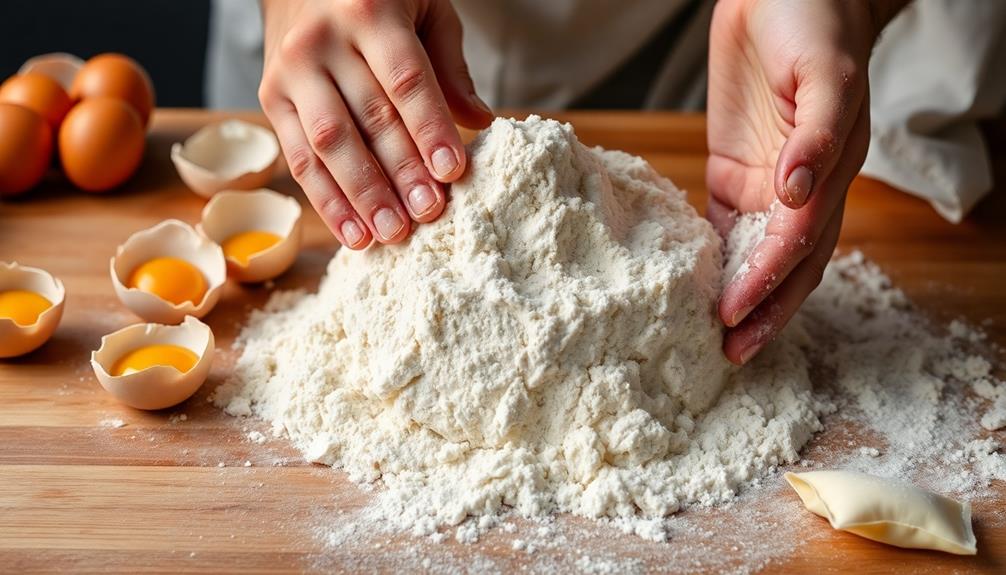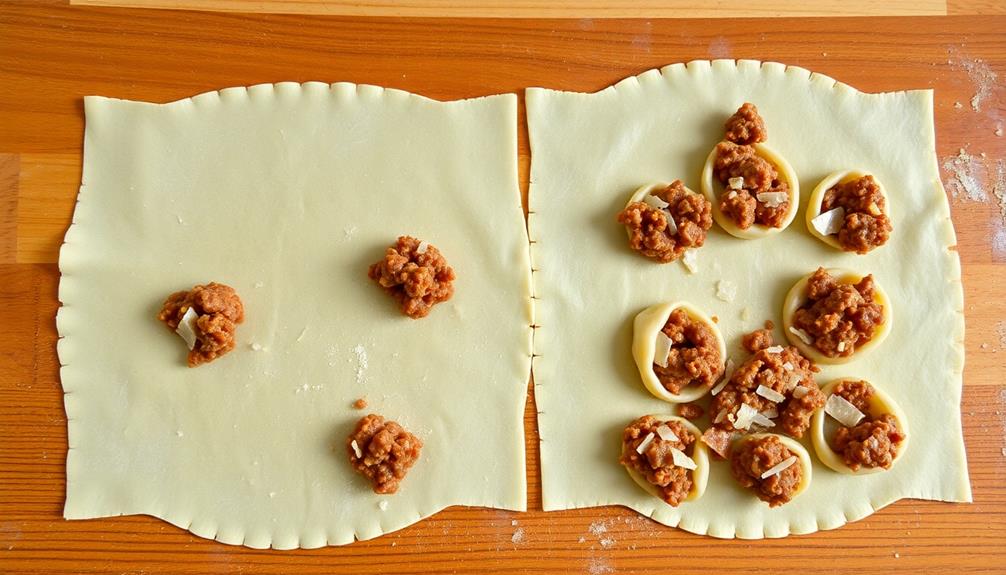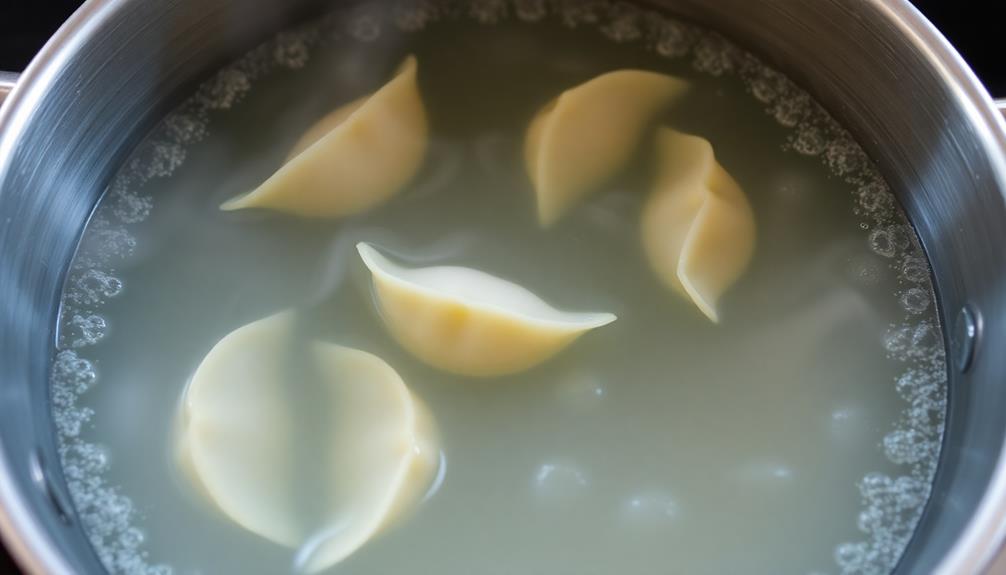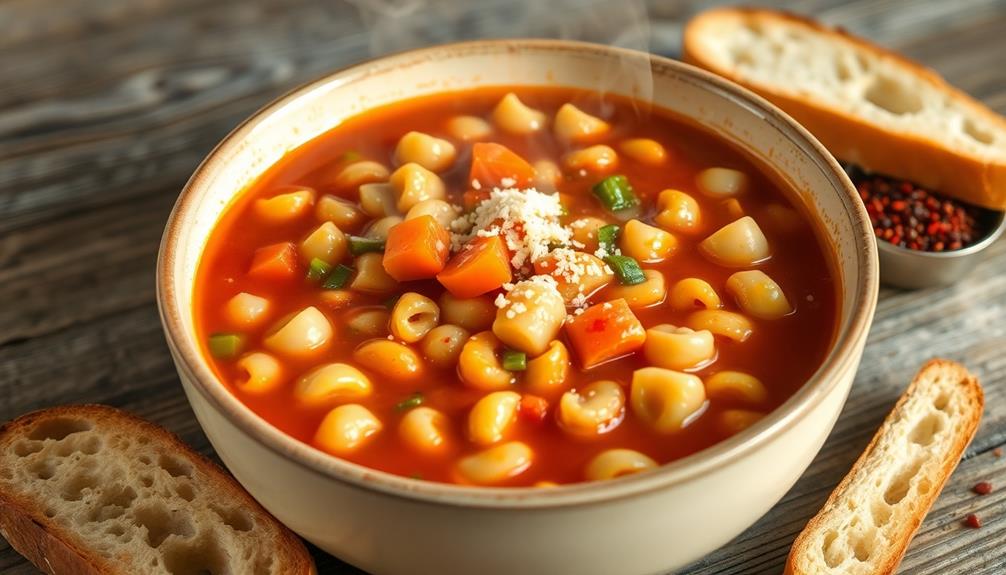Agnolotti, the delightful Italian pasta parcels, have captivated culinary enthusiasts for centuries. These half-moon shaped delights originated in the Piedmont region, evolving over time to reflect unique regional flavors. Crafting agnolotti is a labor of love, as you'll prepare fresh pasta dough and flavorful fillings. Whether you choose traditional ingredients like meat and cheese or get creative with seasonal produce, the result is a satisfying and joyful dish. Pair your agnolotti with vibrant sauces or let the pasta shine on its own. This cherished Italian tradition continues to inspire home cooks and chefs alike – there's more to discover about this beloved pasta!
Key Takeaways
- Agnolotti is an Italian pasta variety typically stuffed with a range of fillings, such as cheese, meat, or vegetables, and characterized by its distinctive half-moon shape.
- The origins of agnolotti can be traced back to the 14th century in the Piedmont region of Italy, reflecting the country's rich culinary heritage.
- Preparing agnolotti is considered a labor of love, requiring the crafting of fresh pasta dough and the careful assembly of the delicate pasta pockets.
- Agnolotti is often served in broth or with various sauces, such as light, vibrant sauces or creamy sauces, to complement the delicate flavors of the dish.
- Agnolotti is celebrated as a cherished Italian pasta that brings comfort, satisfaction, and joy, and is commonly enjoyed during family gatherings and special occasions.
History
Agnolotti, a beloved pasta variety, has a rich history dating back to the 14th century in the Piedmont region of Italy. This cherished delicacy was first created by ingenious Italian chefs, who skillfully folded and filled delicate pasta dough with savory fillings.
Over the centuries, the recipe has been passed down, evolving to reflect the unique flavors of the Piedmont region. Today, agnolotti is celebrated as a true taste of Italian heritage, prepared with care and pride.
Whether filled with meat, cheese, or vegetables, each bite is a delightful explosion of flavors. Families gather around the table, sharing stories and laughter as they savor this beloved pasta.
The history of agnolotti is a testament to the enduring culinary traditions of Italy, inspiring home cooks and professional chefs alike to preserve this age-old delicacy for generations to come.
Recipe
Agnolotti is a type of Italian pasta that originated in the Piedmont region. These small, half-moon shaped ravioli are typically filled with a mixture of meat, cheese, or vegetables, and served with a variety of sauces.
To make homemade agnolotti, you'll need to prepare a pasta dough and a flavorful filling. While the process may seem daunting, the end result is well worth the effort, as the delicate texture and rich flavors of this dish are sure to impress your guests.
Ingredients:
- 2 cups all-purpose flour
- 3 large eggs
- 1 teaspoon salt
- 1 lb ground beef
- 1 onion, finely chopped
- 2 cloves garlic, minced
- 1 cup ricotta cheese
- 1/2 cup grated Parmesan cheese
- 2 tablespoons chopped fresh parsley
- Salt and pepper to taste
Cooking Instructions:
In a large bowl, combine the flour, eggs, and salt. Knead the dough until it becomes smooth and elastic. Cover and let it rest for 30 minutes.
In a skillet, cook the ground beef, onion, and garlic until the beef is browned and the onion is translucent. Drain any excess fat, then transfer the mixture to a bowl. Add the ricotta, Parmesan, and parsley, and mix well. Season with salt and pepper.
Divide the pasta dough into two equal pieces. On a lightly floured surface, roll out each piece into a thin sheet. Place tablespoons of the filling mixture onto one sheet, leaving space between each mound. Brush the exposed dough with water, then place the second sheet of dough on top and press around the filling to seal. Use a ravioli cutter or a sharp knife to cut the agnolotti into individual pieces.
When serving, you can dress the agnolotti with a variety of sauces, such as a simple butter and sage sauce, a tomato-based sauce, or a creamy mushroom sauce. The versatility of this dish makes it a perfect choice for a special occasion or a cozy family dinner.
Cooking Steps
Making homemade agnolotti is a delightful experience.
First, you'll craft the pasta dough, then roll it out into thin sheets.
Next, you'll fill those sheets with a tasty mixture before crimping and sealing the pasta.
Step 1. Make Pasta Dough

To begin the process of making pasta dough, you'll need a few key ingredients and tools. First, gather all-purpose flour, eggs, and a pinch of salt. You'll also need a clean, flat surface for kneading and a rolling pin to shape the dough.
Start by pouring the flour onto your work surface, creating a well in the middle. Crack the eggs into the well and add the salt. Using a fork, gently incorporate the eggs into the flour, slowly bringing in more flour from the sides.
Once the dough starts to come together, use your hands to knead it for about 5 minutes, until it becomes smooth and elastic.
Next, cover the dough with a clean towel and let it rest for 30 minutes. This allows the gluten to develop, making the dough easier to roll out.
When ready, use the rolling pin to flatten the dough into thin, even sheets, perfect for shaping into delicious agnolotti.
Step 2. Roll Out Pasta Sheets

With a well-rested and supple dough, you can now begin the process of rolling it out into thin, even sheets. Dust your work surface lightly with flour to prevent sticking.
Divide the dough into manageable portions, keeping the rest covered to prevent drying. Using a rolling pin, begin rolling the dough, applying even pressure and rotating it frequently. Roll the dough as thinly as possible, aiming for paper-thin sheets. Periodically, lift the dough to ensure it's not sticking, and add more flour as needed.
Once the dough is rolled out, use a sharp knife or pizza cutter to trim the edges, creating clean, rectangular sheets. Stack the sheets, separating them with a light dusting of flour to prevent them from sticking together.
With your thin, uniform pasta sheets ready, you can now move on to shaping the agnolotti, the delicious pasta pockets that will soon grace your table.
Step 3. Fill Pasta Sheets

Once your pasta sheets are ready, you can begin to fill them with the desired ingredients. This is where the fun really starts! Gather your fillings – perhaps a savory blend of cheeses, fresh herbs, or even a hearty meat mixture.
Scoop small portions of the filling onto the pasta sheets, leaving a bit of space around the edges. Be careful not to overfill, as you'll need to seal the agnolotti later.
Gently fold the pasta sheets over the fillings, creating a half-moon shape. Use your fingers to firmly press and seal the edges, ensuring a tight seal. This will help the agnolotti hold their shape during cooking.
Cutting the filled pasta into individual pieces is the next step. Use a sharp knife or pastry cutter to slice the sealed pasta into your desired size and shape.
Voila! Your agnolotti are now ready to be cooked and enjoyed.
Step 4. Crimp and Seal Filled Pasta

After you've neatly arranged the filled pasta sheets, it's time to crimp and seal them. Grab your crimping tool and get ready to work!
Gently place one filled pasta sheet on the tool, making sure the filling is evenly distributed. Then, press down firmly to create those signature crimped edges. Repeat this process for each of your pasta sheets, being careful not to overstuff them.
Once all your pasta is crimped, it's time to seal them up. Dip your fingers in a bit of water and lightly moisten the edges of the pasta. This will help the layers stick together and create a tight seal.
Gently fold the pasta in half, pressing the edges firmly to secure them. Voila! Your delicious agnolotti are now ready to be cooked and enjoyed.
Step 5. Cook in Boiling Water

Bring a large pot of salted water to a rolling boil. Once it's bubbling vigorously, gently drop in those precious agnolotti.
Don't worry – they'll float to the top when they're done! Let them dance in the hot water for just 2-3 minutes. You'll know they're ready when they're tender and pillowy.
Drain the agnolotti carefully, then return them to the pot. Toss them with your favorite sauce – maybe a simple garlic-butter or a bright, herby pesto.
The pasta will soak up all those delectable flavors. Sprinkle with freshly grated Parmesan for the perfect finishing touch. Mmm, doesn't that sound divine?
Serve the agnolotti immediately, while they're hot and at their best. This quick-cooking filled pasta is the ultimate in comfort and convenience.
Your family will love digging into these little flavor-packed pockets. Buon appetito!
Final Thoughts
Agnolotti, a cherished Italian pasta, is a delightful culinary exploration that transcends the boundaries of simplicity. Whether you're hosting a family gathering or indulging in a solo meal, these delicate parcels of flavor will leave you with a smile and a satisfied palate. The traditional filling of agnolotti is a savory blend of meat, cheese, or vegetables, enveloped in a thin layer of pasta dough. These potatobased dumplings add a layer of richness and heartiness to the dish, making it a favorite comfort food in Italian cuisine. Whether served with a light butter and sage sauce or a hearty meat ragu, agnolotti are sure to delight your taste buds and leave you craving for more.
Crafting the perfect agnolotti is a labor of love, but the rewards are immeasurable. The dance between the dough, the filling, and the sauce is a symphony of textures and tastes that will delight your senses.
Serve them with a light, vibrant sauce that complements the delicate flavors, or let them shine on their own with a drizzle of high-quality olive oil.
As you savor each bite, remember that the true essence of agnolotti lies not only in its taste but also in the joy of sharing it with loved ones.
Embrace the tradition, experiment with new fillings, and let the flavors transport you to the heart of Italian culinary excellence.
Frequently Asked Questions
How Long Can Fresh Agnolotti Be Stored?
Fresh pasta, like agnolotti, can be stored in the refrigerator for 3-5 days. Keep it in an airtight container and use it within this timeframe for the best texture and flavor. Freezing can extend its shelf life even further.
Can Agnolotti Be Frozen and Reheated?
Yes, you can freeze and reheat agnolotti. Freeze the uncooked pasta for up to 3 months. When ready to eat, simply boil or sauté the frozen agnolotti until heated through, then serve with your favorite sauce.
What Is the Best Way to Reheat Leftover Agnolotti?
The best way to reheat leftover agnolotti is to gently simmer them in a skillet with a bit of broth or sauce. This will help them retain their texture and flavor without drying them out.
Can Vegetarian Fillings Be Used in Agnolotti?
You can definitely use vegetarian fillings in agnolotti. The pasta itself is just a shell, so you can get creative with the stuffing. Try fillings like roasted vegetables, mushrooms, or even a plant-based cheese for a delicious meatless option.
Are There Any Gluten-Free Options for Agnolotti?
Yes, there are gluten-free options for this traditional Italian pasta. You can make agnolotti with gluten-free flour blends or opt for fillings that don't contain gluten, allowing you to enjoy this dish even with dietary restrictions.










